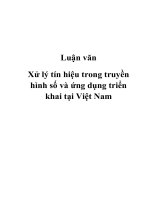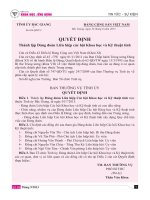Ceva va ung dung NHOM zero thang 1 nam 2015
Bạn đang xem bản rút gọn của tài liệu. Xem và tải ngay bản đầy đủ của tài liệu tại đây (110.63 KB, 6 trang )
Nguyễn Thanh Dũng, Chu Van An high school for gifted students,
Lang Son province.
Nguyễn Việt Hà, Lao Cai high school for gifted students.
Trần Ngọc Thắng, Vinh Phuc high school for gifted students.
Lê Anh Chung , Bac Kan high school for gifted students.
Trương Thanh Tùng, Thai Nguyen high school for gifted students.
Phạm Thị Thu Trang, Le Quy Don high school for gifted students,
Dien Bien province.
Đinh Ngoc Diệp, Ha Giang high school for gifted students.
Nguyễn Dũng, Nguyen Trai high school for gifted students, Hai
Duong province.
Do Son, 01/23/2015
The lesson of zerogroup.
Ceva’theorem and its applications
A. Learning outcomes for Ceva Theorem
-Learners are able to explain and express Ceva’theorem and use it in
solving geometric problems in VMO, IMO.
-To understand the content of this theorem and apply it to solve the
specific mathematical problems.
-To recognize that what signs in the mathematical problems can help
learners to think of Ceva’theorem.
- To creat some similar problems.
B. Vocabulary needed for the lecture
* Content-obligatory language
Keywords which teachers and learners need in order to understand the
topic (need written in Boll Font)
Word-phrase
Triangle
Meaning
Tam giác
Angle
Segment
Ratio
Concurrent (adj)
Concurrency (n)
Internal bisector, external bisector
Altitude
tangent
The content of lesson
Inductive method
1.Phát biểu nội dung định lý
Góc
Đoạn thẳng
Tỉ số
đồng quy
Đồng quy
Phân giác trong, phân giác ngoài
Đường cao
Tiếp xúc
Activating prior knowledge
+ Let M, N, P be the midpoints of the sides BC, CA, AB of a
triangle ABC. Calculate the expression
MB NC PA
.
.
.
MC NA PB
+ Given a triangle ABC. Let M, N, P be the feet of the internal
angle bisectors. Calculate the expression
MB NC PA
.
.
.
MC NA PB
What is the relationship of that results and the concurrency of three
lines AM, BN, CP?
Theorem: Let ABC be a triangle and D, E, F be points on the lines BC,
CA, AB respectively. If AD, BE, CF are concurrent (i.e. meet at a point
P), then
AF BD CE
.
.
= +1.The + sign emphasizes directed segments were used
FB DC EA
here.
We can see the content of the theorem in following example:
a) Given the triangle ABC, then its medians concur
b) Given the triangle ABC, then its internal bisectors concur
2.Áp dụng vào 1 vài ví dụ dễ hiểu, áp dụng trực tiếp lý thuyết
Example 1: Let ∆ABC be a triangle and let L, M, and N, be the points
of tangency of the inscribed circle to the sides of the triangle opposite
vertices A, B, and C, respectively. The line segments AL, BM, and CN
are concurrent.
Proof. Let ∆ABC be a triangle. Construct the inscribed circle to ∆ABC
and let L, M, and N, be the points of tangency of the inscribed circle to
the sides of the triangle opposite vertices A, B, and C, respectively. See
Figure ??. Since AM and AN are common external tangent segments to
the inscribed circle, they are congruent. Similarly, BL and BN are
congruent and CL and CM are congruent. Hence,
AM CL BN AM CL BN
. .
=
.
.
= 1.
MC BL AN AM CM BL
By Ceva’s Theorem, the segments AL, BM, and CN are
concurrent.
Note: The concurent point of AL, BM, CN is called Gergonne point.
- Ask students to rewrite the solution in their own thinking (method).
Example 2. Let ∆ABC be a triangle and let L, M, and N, be the points
of tangency of the excircle to the sides of the triangle opposite vertices
A, B, and C, respectively. The line segments AL, BM, and CN are
concurrent.
Proof. Similar to Example 1.
Example 3. Given triangle ABC. Prove that: Three altitudes concur.
3.Some problems from VMO, IMO.
-Một số lưu ý khi sử dụng định lý này hoặc những sai lầm dễ mắc khi
sử dụng định lý?
-Những dấu hiệu nhận biết trong đề: định lý này sẽ được sử dụng
hiệu quả…?
-….
1. Let ABCDE be a convex pentagon such that ∠BAC = ∠CAD =
∠DAE and ∠ABC = ∠ACD = ∠ADE. The diagonals BD and CE meet
at P. Prove that the line AP bisects the side CD. (USA)
Solution.
Let the diagonals AC and BD meet at Q, the diagonals AD and CE meet
at R, and let the ray AP meet the side CD at M.
We want to prove that CM = MD holds.
The idea is to show that Q and R divide AC and AD in the same ratio, or
more precisely
AQ AR
=
QC RD
(1)
(which is equivalent to QR || CD). The given angle equalities imply that
the triangles ABC, ACD and ADE are similar. We therefore have:
AB AC AD
=
=
AC AD AE
Since ∠BAD = ∠BAC + ∠CAD = ∠CAD + ∠DAE = ∠CAE , it follows from
AB AD
=
that the triangles ABD and ACE are also similar. Their angle
AC AE
bisectors in A are AQ and AR, respectively, so that
AB AQ
=
.
AC AR
AB AC
AQ AC
=
=
Because
, we obtain
, which is equivalent to (1). Now
AC AD
AR AD
Ceva’s theorem for the triangle ACD yields
AQ CM DR
.
.
= 1.
QC MD RA
In view of (1), this reduces to CM = MD , which completes the proof.
Comment. Relation (1) immediately follows from the fact that
quadrilaterals ABCD và ACDE are similar.
Home work
Problem 1. Connect each vertex of a triangle to the point where its
incircle is tangent to the opposite side. Prove that the three resulting
segments have a common point. (It is called Gergonne’s point.)
Problem 2. Prove that the altitudes of a triangle have a common point.
Problem 3. Let ABC be a triangle and let P be a point. Lines AP, BP, CP
are reflected across the bisectors of angles CAB, ABC, BCA
respectively. Prove that the resulting lines have a common point (or are
parallel). Their common point is called the isogonal conjugate of P.
Problem 4. Points A1 , B1 , C1 are chosen on sides BC, CA, AB of triangle
ABC respectively so that AA1 , BB1 , CC1 are concurrent. Let A2 be the
reflection of A1 across the midpoint of BC. Define B2 , C2 similarly. Prove
that AA2 , BB2 , CC2 are concurrent (or parallel). Their common point is
called the isotomic conjugate of P.
Problem 5. Points A1 , B1 , C1 are chosen on sides BC, CA, AB of triangle
ABC respectively so that AA1 , BB1 , CC1 are concurrent. Let A2 , B2 , C2 be the
midpoints of sides BC, CA, AB respectively.
(a) Prove that the lines parallel to AA1 , BB1 , CC1 through A2 , B2 , C2
respectively are concurrent.
(b) Prove the the lines connecting A2 , B2 , C2 with the midpoints of
AA1 , BB1 , CC1 respectively are concurrent.
Problem 6. Let α, β, γ be angles such that the sum of any two of them
does not exceed π. Triangles ABC1 , BCA1 , CAB1 are constructed on the
interior of triangle ABC such that their angles at A, B, C are α, β, γ
respectively. Prove that lines AA1 , BB1 , CC1 are concurrent.
Problem 7. Let the tangents to the circumcircle of triangle ABC at B
and C meet at A1 . Define points B1 , C1 similarly. Prove that AA1 , BB1 , CC1
are concurrent. Their common point is called Lemoine’s point.
Problem 8. Prove that Lemoine’s point of a triangle is the isogonal
conjugate of its centroid.
Problem 9. A circle intersects sides AB, BC, CA of triangle ABC at
points C1 and C2 , A1 and A2 , B1 and B2 respectively. Prove that lines
AA1 , BB1 , CC1 are concurrent iff lines AA2 , BB2 , CC2 are concurrent.
Problem 10. Let ABCD be a convex quadrilateral inscribed into a circle
ω. Rays AB and DC meet at P. The tangents to ω at A and D meet at M
and tangents to ω at B and C meet at N. Prove that P, M, N are collinear.









